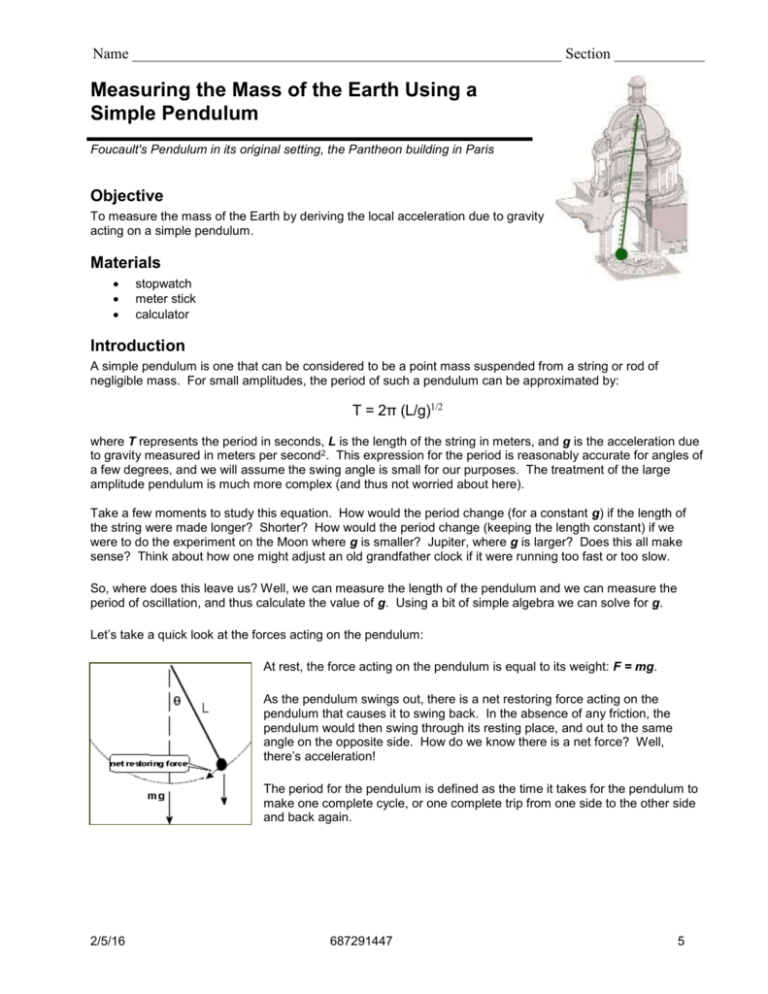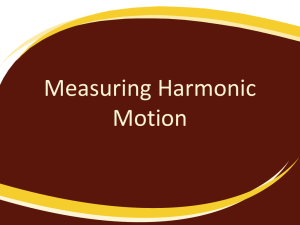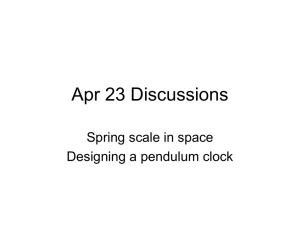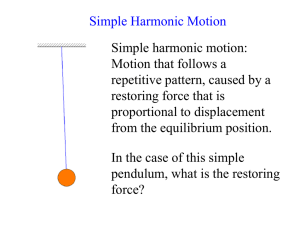Measuring the Mass of the Earth Using a Simple Pendulum
advertisement

Name _________________________________________________________ Section ____________ Measuring the Mass of the Earth Using a Simple Pendulum Foucault's Pendulum in its original setting, the Pantheon building in Paris Objective To measure the mass of the Earth by deriving the local acceleration due to gravity acting on a simple pendulum. Materials stopwatch meter stick calculator Introduction A simple pendulum is one that can be considered to be a point mass suspended from a string or rod of negligible mass. For small amplitudes, the period of such a pendulum can be approximated by: T = 2π (L/g)1/2 where T represents the period in seconds, L is the length of the string in meters, and g is the acceleration due to gravity measured in meters per second2. This expression for the period is reasonably accurate for angles of a few degrees, and we will assume the swing angle is small for our purposes. The treatment of the large amplitude pendulum is much more complex (and thus not worried about here). Take a few moments to study this equation. How would the period change (for a constant g) if the length of the string were made longer? Shorter? How would the period change (keeping the length constant) if we were to do the experiment on the Moon where g is smaller? Jupiter, where g is larger? Does this all make sense? Think about how one might adjust an old grandfather clock if it were running too fast or too slow. So, where does this leave us? Well, we can measure the length of the pendulum and we can measure the period of oscillation, and thus calculate the value of g. Using a bit of simple algebra we can solve for g. Let’s take a quick look at the forces acting on the pendulum: At rest, the force acting on the pendulum is equal to its weight: F = mg. As the pendulum swings out, there is a net restoring force acting on the pendulum that causes it to swing back. In the absence of any friction, the pendulum would then swing through its resting place, and out to the same angle on the opposite side. How do we know there is a net force? Well, there’s acceleration! The period for the pendulum is defined as the time it takes for the pendulum to make one complete cycle, or one complete trip from one side to the other side and back again. 2/5/16 687291447 5 Now, we need to bring in Newton and his law of gravity: F = GMm/R2 where F is force, G (also known as big G) is the universal constant of gravitation (6.67 x 10-11 m3/kg s2), M is the mass of the Earth, and m is the mass of an object on the surface of the Earth. This force is exactly the same force that gives the pendulum its weight: F = mg. If we equate the two, we find that the mass of the object cancels. We then do some additional algebraic manipulation to solve for the mass of the Earth and get our equation in final form. Since we "know" R to be 6,378 km (=6,378,000 m; let's say we measured it somehow by observing the length and angles of shadows at different places on the Earth's surface—sound familiar?) and G was fortunately measured for us by a physicist, all we need is g, the acceleration of an object at the Earth's surface. Procedure We will be using a pendulum set up in the classroom. Working in groups of 4-5, determine who will be the timekeeper, who will be recording the data, who will be determining the length of the pendulum cable, who will be quality control, who has the calculator, etc. As part of the scientific process, we try to make as many measurements as reasonably possible so that we average out the random errors (some of our values will be too high, some too low). Try to make at least 10 timings of the period of the pendulum, and average your results. Think about ways to minimize any systematic error (errors that are always too high or always too low). One example of a systematic error is having your reaction time be a major fraction of the time it takes the pendulum to complete one cycle (another way of stating the period is the time it takes for the pendulum to complete one cycle). Data and Calculations Share this data with the other members of your team. For mathematical understanding, each team member should do the calculations individually. In the space below,record 20 trials of the period you measure from the stop watch. 6 1. Average time for the period of the pendulum T: _____________ seconds 2. Calculate the uncertainty in this average (via an approximate method): Toss out the longest and shortest times Subtract the now-shortest time from the now-longest time and divide by 2 Uncertainty: _________ seconds Find a calculator that has statistical capabilities, enter your data and find the standard deviation. This would be a more formal measure of the uncertainty in the period. Standard dev: _________ seconds 3. What is the length of the pendulum cable? ______________ meters 4. There is probably no real quantitative way to determine the uncertainty in your determination of the length of the pendulum cable. How accurate do you think your value is? +/- 1 meter? +/- 0.1 meter (10 cm)? +/- 0.01 meter (1 cm)? +/- 0.001 meter (1 mm)? Uncertainty: ____________ meters 5. Solve first for the acceleration due to gravity, using the values of L and T determined in your experiment. g = ________ m/s2 6. Then solve for the mass of the Earth: M = ____________ kg 7. Look up the values for g and M on the internet, comment. 7









